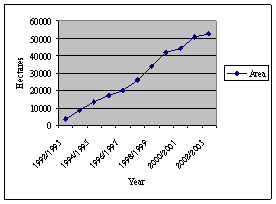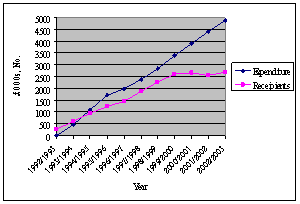
THE STATE OF SCOTLAND'S FARMED ENVIRONMENT 2005
28. THE SFGS: FARMLAND PREMIUM
Uptake
The number of agreements under the predecessor, the Farm Woodland Premium Scheme, rose steadily during the duration of the scheme from 1992 to 2003 to 2689 agreements and an area cover of 52,521 hectare in 2003. Expenditure rose from £14,000 in the first year to £4.9 million at the end of the financial year 2002/2003 (SNH, 2004).
 |
 |
Figure 28.1 : Uptake of the Farm Woodland Premium scheme
Source: SNH (2004)
For 2004 the annual report of the administration of CAP schemes in Scotland (SEERAD, 2005b) provides regional uptake data for recipients and payments made under the old commitments of the Farm Woodland Premium Scheme. Table 28.2 summarises the regional uptake data for the year 2004. Table 28.2 shows a high uptake with relatively large payments in particular in the North-East of Scotland ( Aberdeen City , Aberdeenshire & North East Moray) but also in some Western and Northern regions (Caithness & Sunderland, Ross and Cromarty and Lochaber, Skye & Lochalsh and Argyll & the Islands ) and Perth & Kinross and Stirling . Relatively low uptakes can be found, for example, on the Western Isles, East & North Ayrshire and Mainland and East & Midlothian. Overall, £5.15 million have been paid to farmers for afforestation of farmland through the FWPS in 2004.
Table 28.2 : Total recipients and payments by Scottish sub-regions (NUTS 3) for scheme year 2004
|
Recipients |
Payments (£’000) |
Aberdeen City , Aberdeenshire & North East Moray |
311 |
1338 |
Angus & Dundee City |
65 |
134 |
Clackmannanshire & Fife |
78 |
232 |
East & Midlothian |
49 |
53 |
Borders |
225 |
282 |
City of Edinburgh |
8 |
29 |
Falkirk |
18 |
81 |
Perth & Kinross and Stirling |
218 |
477 |
West Lothian |
25 |
102 |
East and West Dunbartonshire & Helensburgh & Lomond |
* |
* |
Dumfries & Galloway |
151 |
333 |
East & North Ayrshire and Mainland |
33 |
82 |
Glasgow City |
0 |
0 |
Inverclyde, East Renfrewshire & Renfrewshire |
* |
* |
North Lanarkshire |
30 |
154 |
South Ayrshire |
35 |
185 |
South Lanarkshire |
45 |
296 |
Caithness & Sunderland, Ross and Cromarty |
222 |
641 |
Inverness & Nairn, Moray, Badenoch & Strahspey |
73 |
178 |
Lochaber, Skye & Lochalsh and Argyll & the Islands |
184 |
424 |
Western Isles |
36 |
77 |
Orkney Islands |
* |
* |
Shetland Islands |
* |
* |
Scotland Total |
1824 |
5152 |
Source: SEERAD (2005b)
In addition to the existing commitments in the FWPS, nearly one hundred claims under the new SFGS: Farmland Premium have been made in the scheme year 2004 with an average value of £2,232 per claim, in total £0.2 million (SEERAD, 2005b).
EVALUATION
The Scottish Executive (2005a) concludes that about 60 percent of the area planted can be directly attributed to the FWPS and that without the FWPS planting would have significant reduced, in particular on arable and cropping land. The scheme SFGS: Farmland Premium is expected to have a similar impact, estimated at an afforestation area of 8000 hectares in 2005 and 2006 (SEERAD, 2005a). However, it is important to note that payments under the FWPS and SFGS: Farmland Premium are based on income foregone instead of the costs of woodland establishment or the value of benefits delivered.
With respect to environmental impacts, the review of the FWPS carried out in 2002 (Forestry Commission, 2002) concluded that despite having landscape, habitat and biodiversity objectives, the FWPS is untargeted in terms of environmental objectives it is aiming to achieve. The review suggests moving more closely towards the functioning of the Rural Stewardship Scheme by linking objectives and targeting priorities to biodiversity aims as expressed through LBAPs and other local strategies (Forestry Commission, 2002).
Similar to the SFGS, it is important that sufficient efforts and resources are allocated to the management of farm woodland to maintain environmental benefits in the longer term. Recognizing the need for improved woodland management, farm woodland planning and farm woodland management measures have been included in the new LMC Menu Scheme, but preliminary figures on the uptake of the forestry measures in the LMC Menu Scheme indicate that the uptake of these two measures has been rather low. Low uptake of forestry measures by farmers is a common problem, restricting the amount of woodland planted on agricultural land. Hence, farmers’ attitude towards tree planting is a crucial aspect to consider in future forestry planning, if the key aspiration of the Scottish Forestry Strategy (SFS) of 25% woodland cover by 2050 has to be fulfilled.
Sources
Forestry Commission (2005). SFGS Applicant’s Booklet Online. External Website
Forestry Commission (2002). Review of WGS/FWPS. External Website
Scottish Natural Heritage (2004). Natural Heritage Trends: Agri-environment schemes. External Website
SEERAD (2005a). Rural Development Regulation (EC) No 1257/1999: Rural Development Plan for Scotland (Amended February 2005) External Website
SEERAD (2005b). The Administration of Common Agricultural Policy Schemes in Scotland Annual Report 2004. External Website
National Parks >>


